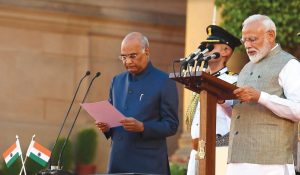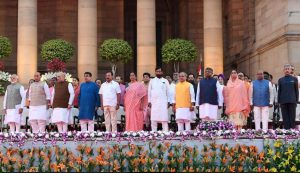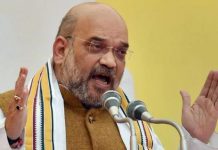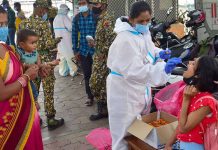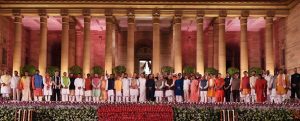 After an unprecedented victory run for the BJP and NDA harped on the narrative of nationalism, Team Modi led by Prime Minister, Narendra Modi has taken the oath of office and secrecy. Modi is the Prime Minister for a second consecutive term. The swearing in ceremony was held at the sprawling forecourt of the Rashtrapati Bhavan. President Ram Nath Kovind administered the oath to Modi, 24 Cabinet colleagues, nine Ministers of State (Independent Charge) and 24 Ministers of State.
After an unprecedented victory run for the BJP and NDA harped on the narrative of nationalism, Team Modi led by Prime Minister, Narendra Modi has taken the oath of office and secrecy. Modi is the Prime Minister for a second consecutive term. The swearing in ceremony was held at the sprawling forecourt of the Rashtrapati Bhavan. President Ram Nath Kovind administered the oath to Modi, 24 Cabinet colleagues, nine Ministers of State (Independent Charge) and 24 Ministers of State.
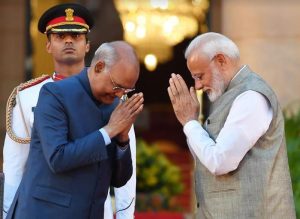 A significant development was the induction of the BJP chief Amit Shah who was sworn in at number three after Prime Minister Narendra Modi and Cabinet Minister, Rajnath Singh. The induction of Amit Shah, who was instrumental to bring BJP to power in 2014 and 2019 with his unique organizational capabilities, is a vital development. His induction into the Cabinet means the party will have to elect a new president.
A significant development was the induction of the BJP chief Amit Shah who was sworn in at number three after Prime Minister Narendra Modi and Cabinet Minister, Rajnath Singh. The induction of Amit Shah, who was instrumental to bring BJP to power in 2014 and 2019 with his unique organizational capabilities, is a vital development. His induction into the Cabinet means the party will have to elect a new president.
As J.P.Nadda, a minister and a performer have been dropped from the Cabinet, it is being anticipated that be might be considered to be president of the BJP. Sources say that there is a strong possibility of Nadda who had earlier worked as a general secretary o the BJP, being elevated as party president. He is among the frontrunners for the top job to replace Amit Shah.
Shah had taken over as BJP chief in July 2014 after then party chief Rajnath Singh who was earlier chief minister of Uttar Pradesh joined the Modi cabinet in 2014. With the BJP constitution prescribing two terms for a sitting president, which Shah has already completed, the party was already looking for his replacement. However, the benchmarks set by Shah would be difficult to meet by his successor. In fact, it will be a huge challenge for the successor. J.P.Nadda, a former three-time Himachal MLA, is known for his proximity to Shah and was brought in as secretary of the BJP central parliamentary board in 2009 by the party president Nitin Gadkari. In the recent LS polls, Nadda supervised the party’s organisational machinery in Uttar Pradesh, where it won 62 of the 80 parliamentary constituencies. His strategy worked and the “mahagathbandhan” could not pose a major hurdle to BJP in Uttar Pradesh. The next BJP chief will need to lead the party in the state elections in Haryana, Maharashtra, and Jharkhand this year and in Delhi in 2020. However, the major task for the new BJP President would be to keep the allies of NDA in good
humour too.
Among the allies, Lok Janshakti Party chief Ram Vilas Paswan retained his place in the Cabinet, as did Harsimrat Kaur Badal of the SAD. Harsimrat Kaur Badal has now become the only nominee from Punjab to find a place in Union Cabinet for a second consecutive term. Arvind Sawant, who defeated Milind Deora in South Mumbai, made it from the Shiv Sena quota. There was no representation from Tamil Nadu. Tamil-speaking Nirmala Sitharaman, who took oath as a Cabinet minister, represents Karnataka in Rajya Sabha.
BJP nominees
Besides Shah, the new members from the BJP include Prahlad Joshi, former Chief Ministers Ramesh Pokhriyal Nishank and Arjun Munda, while party’s UP chief Mahendra Nath Pandey makes a comeback into the Council of Ministers and has been elevated to Cabinet rank, as was Giriraj Singh, who was MoS (Independent Charge) earlier. Former Foreign Secretary S Jaishankar was the lone surprise inductee into the Cabinet, becoming the second former ranking Indian Foreign Service officer to be drafted into the new team led by Modi. Modi has retained former diplomat Hardeep Singh Puri as Minister of State (Independent Charge).
Missing among the Cabinet ministers from the outgoing government were Arun Jaitley and Sushma Swaraj. While the former opted out, Swaraj did not contest the polls, both citing health concerns. Similarly, missing from the MoS (Independent Charge) list were Dr Mahesh Sharma, Rajyavardhan Singh Ratho-re and K Alphons, while Manoj Sinha failed to make the cut as he lost the election. The new Ministers of State include Nityanand Rai, Suresh Angadi and first-time MPs G Kishan Reddy (Telangana), Debosree Chowdhury (West Bengal) and Pratap Chandra Sarangi (Odisha).
The historic forecourt of Rashtrapati Bhavan, hosted an audience of around 6,000-7000 people including politicians, businessmen and movie personalities for the swearing-in ceremony of Narendra Modi’s second government. In all, 58 ministers were administered their oaths of office by President Ram Nath Kovind, who gently ticked off one or two for skipping keywords and helpfully prompted a few others. The around 110-minute-long programme was gustily cheered on by Modi and Bharatiya Janata Party supporters with chants of “Bharat Mata Ki Jai”.
Among the business leaders who attended the event were Mukesh Ambani of Reliance Industries, Ratan Tata and N Chandrasekaran of the Tata group, Kumar Mangalam Birla of the Aditya Birla Group, Gautan Adani, Ajay Piramal, Uday Kotak, Bharti Enterprises’ Rajan Mittal, Arcelor Mirral’s LN Mittal, PayTM’s Vijay Shekhar Sharma, Infosys’s NR Naraya Murthy. Among the film stars were Anupam Kher (although he was also the plus-one of his wife, Chandigarh MP Kirron Kher), Kangana Ranaut, Sushant Singh Rajput, and Rajnikanth. Director Karan Johar and producer Boney Kapoor were also present.
Among others, former Prime Minister, Dr. Manmohan Singh, UPA Chairperson, Sonia Gandhi, Congress President, Rahul Gandhi, Uttar Pradesh chief minister Yogi Adityanath, BJP veterans LK Advani and Murli Manohar Joshi, former president Pratibha Patil, speaker of the outgoing Lok Sabha Sumitra Mahajan, vice president M. Venkaiah Naidu, leaders of the BJP allies including the Shiv Sena’s Uddhav Thackeray, the Akali Dal’s Prakash Singh Badal and Sukhbir Badal, and the Janata Da (United)’s Nitish Kumar were also present.
Although not too many opposition leaders were present at the event, United Progressive Alliance chairperson Sonia Gandhi and Congress president Rahul Gandhi came together and sat in the first row. As did former Prime Minister Manmohan Singh. BJP leader Uma Bharti could be seen briefly chatting with a smiling Sonia Gandhi. But the journey of the new government of India, riding high on the expectations of the people in a difficult time, has just started.
Already, there are rumblings in the alliance partners though BJP has a brute majority of its own. The swearing in ceremony was marred by ally Janata Dal (United) deciding not to take oath even as party chief Nitish Kumar marked his presence by attending the ceremony. In a first sign of rumblings within the National Democratic Alliance (NDA), the Janata Dal (United) announced on Thursday that it would not be a part of the Union government at the Centre.
Bihar chief minister Nitish Kumar, who heads the JD(U) and was present for the oath-taking ceremony on the forecourt of the Rashtrapati Bhavan, said his party will not be part of the NDA government as the Bharatiya Janata Party’s (BJP) offer of participation was “symbolic representation.” “They said that they want to give one cabinet rank to every ally. Then we said that we will discuss it with the party members and then only we can say anything over this symbolic representation.” “I spoke to my party leaders and people and they were not agreeing to one berth and the symbolic representation. And this we communicated to them (BJP). They also called up in the morning and then we again conveyed our decision.”
The JD(U), which rules Bijhar in alliance with the BJP and won 16 of the 40 seats in the state, wanted a bigger share in the council of ministers and had conveyed its demand to the BJP, which won 17 seats. It was not part of the Modi government in the last tenure and had walked out of the Congress –Rashtriya Janata Dal alliance in Bihar in 2017 to be part of the NDA. Little doubt that peeved at being allocated only one cabinet berth, Bihar chief minister Nitish Kumar-led Janata Dal-United (JD-U) has decided to opt out of the Narendra Modi government. Nitish Kumar reiterated that “The offer made by the BJP was not acceptable to us. But we are firmly with the National Democratic Alliance. But we will not join the government.” Earlier, sources had said that JD-U’s senior leader and Nitish Kumar’s close aide, RCP Singh was to become the lone cabinet minister from the party. A closed-door meeting in New Delhi consisting of the chief minister and top leaders of the JDU decided to not attend the swearing-in ceremony. Earlier, Kumar had met BJP president Amit Shah on JD-U’s expectations of being invited to be a part of the new government.
Rajya Sabha MP RCP Singh had also received a cabinet call earlier in the day. Singh is a former Uttar Pradesh cadre Indian Administrative Service (IAS) officer and belongs to the Nalanda district of Bihar. He belongs to the same caste as Bihar chief minister Nitish Kumar and is considered close to him. Singh has been associated with Nitish Kumar since his stint in the Atal Bihari Vajpayee government and was also Kumar’s principal secretary in the state government till he joined politics.
The JD-U’s move to identify its representatives in the cabinet comes against the backdrop of the party’s strong performance in the elections to the 17th Lok Sabha, in which it won 16 of the 17 seats that it contested from Bihar. The BJP and the Lok Janshakti Party (LJP) won all 17 seats and six seats, respectively, that they contested, giving the NDA 39 of the 40 Lok Sabha seats in Bihar.
As Prime Minister Narendra Modi and his cabinet were sworn in on Thursday by President Ram Nath Kovind, 37 ministers – including several high-profile

